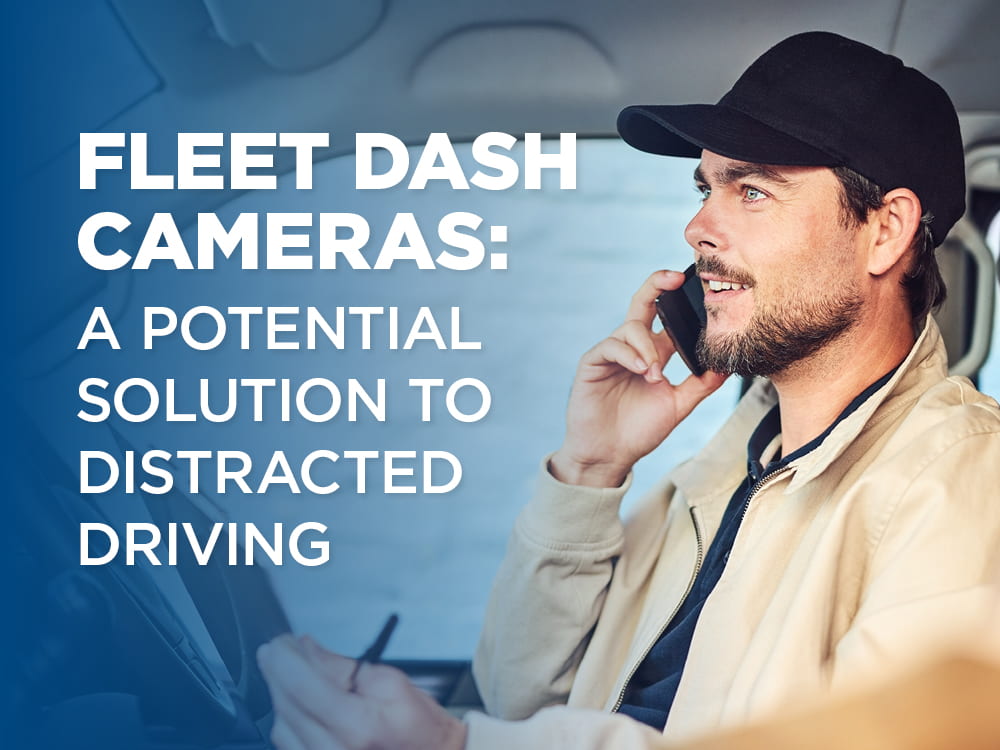- Home
- Loss Control
- Loss Control Insights
- Fleet Dash Cameras: A Potential Solution to Distracted Driving
In today’s connected world, the number of ways a driver can get distracted is nearly endless. Besides the obvious use of a cell phone to text or talk, other distractions could include changing a radio station or selecting a playlist, chatting with a passenger, picking up a dropped object, eating, adjusting a GPS unit and attempting to take off a jacket.
“While it’s impossible to list every imaginable distraction, drivers should be aware that anything that diverts their attention from driving is dangerous,” says Kevin Clayton, EMC Engineering Specialist. “Humans tend to think we can multitask, but we just can’t while driving. This fact is well documented in studies accident reviews.”
How to Use Dash Cams and Implement a Policy
While it’s not popular with drivers, there is really only one way to be sure employees are avoiding distractions. And that’s to use dashboard cameras that film both forward and back. It’s important to explain to drivers that even though the cameras constantly record, footage isn’t saved unless there is an incident. If there is a crash or near collision, the recording is saved as evidence.
“Knowing a camera will capture their every move is the best way to alter a driver’s safety habits,” Kevin explains. However, he insists that dashboard cameras should not be used in a vacuum. A combination of policies and enforcement practices is the best approach to preventing distracted driving. Keep the following best practices in mind when crafting your driver safety program.
- Draft a policy and be sure all employees know and understand the rules. A written policy informs employees on what they must do to remain safe. It also gives you a way to enforce rules and standards. If you don’t have rules in writing, they aren’t enforceable and won’t hold up in court if a crash occurs that may have been caused by distracted driving.
If your policy requires dashboard cameras to be turned on and functioning, employees need to accept that as part of their job. They must also understand how critical the rule is to your company and individual drivers.
- Train drivers on the policy so they fully understand the rules and the consequences of not following them. Training also gives you the opportunity to answer questions about the perceived intrusiveness of dashboard cameras. Use this time to address any other concerns employees may have about the rules.
When asked about the privacy of dashboard cameras, remind employees that the cameras can protect them against legal proceedings in case of a crash, if they were obeying the rules.
- Enforce the rules of the policy. To properly enforce rules, you must have ways to observe if they are being broken. Ride-alongs can also tell you a lot about the driver’s habits.
- Keep the policy in view of employees. While handouts and posters rank low on the Hierarchy of Hazard Control, they do serve as a reminder of what drivers need to do (and not do).
Dashboard Cameras to Prevent Distracted Driving
Not too long ago, cell phone blocking devices were considered a valuable tool in stopping calls and texts while driving. But EMC discovered these devices didn’t reduce collisions. The reason? Drivers used their personal phones—which weren�t affected by the blocker—while driving.
In contrast, dash cameras do change driver behavior. The driver knows they are being recorded and that there are consequences for not obeying company policies. “A camera can undeniably prove that the driver disobeyed company policies, which is punishable by disciplinary action such as firing,” Kevin says.
Get in touch
Need help? We’re here for you! Whether you have questions or need personalized assistance, your local office is ready to support you.
Loss Control Insights
Stay informed with the latest news and receive actionable safety tips, all carefully curated by our team of experts.
